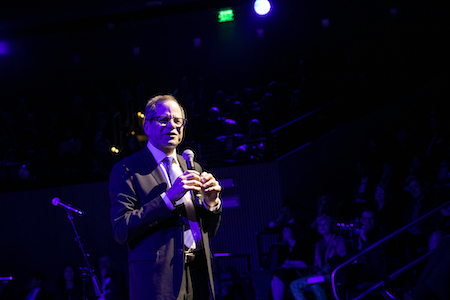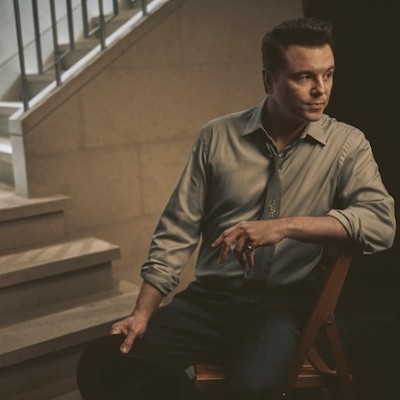Dec 9, 2025 12:28 PM
In Memoriam: Gordon Goodwin, 1954–2025
Gordon Goodwin, an award-winning saxophonist, pianist, bandleader, composer and arranger, died Dec. 8 in Los Angeles.…

Randall Kline
(Photo: Courtesy SFJAZZ)“Scalability” is a popular buzzword among businesses and organizations these days, and DownBeat Lifetime Achievement Award recipient Randall Kline chuckles when that idea of sustained and efficient growth is brought up while discussing the early days of SFJAZZ, which is now an internationally admired jazz entity.
Another “s” word actually came to mind when recalling the events of June 1983. “There was no issue of scaling. It really was survival,” Kline admitted. “It wasn’t successful fiscally in the first year, so we had to regroup and try to think about how to reset.”
At the start of a two-hour interview on the Friday afternoon before Labor Day weekend, SFJAZZ’s founder and executive artistic director was frank about the organization’s early missteps even as he marveled at its accomplishments and was quick to mete out praise to its many internal and external champions.
Enjoying the elevated sightlines of his third floor office in San Franciso’s Hayes Valley performing arts district, he has the benefit of hindsight when revisiting the non-profit’s rough start. Headquartered in its 36,000-square-foot, $64 million SFJAZZ Center, the jazz presentation, education and media group had a $19 million pre-pandemic budget and continues to boast both an all-star house band and a pair of DownBeat Student Music Award-winning groups.
SFJAZZ’s 2022–’23 season, which launched on Sept. 8, features more than 300 concerts over 37 weeks and celebrates the 10th year of the SFJAZZ Center, the nation’s first free-standing building devoted to jazz.
Most shows will be held in its 700-seat Miner Auditorium or at its 107-seat Joe Henderson Labs. A handful will be presented at venues around San Francisco or Oakland, including nearby Herbst Theatre — home to SFJAZZ’s infamous inaugural event.
It’s a far cry from humble beginnings that started as the Jazz in the City Festival. Kline and concert lighting and sound professional Clinton Gilbert had an idea to showcase San Francisco’s talent through a two-day event.
With a budget of $20,000 gathered from the Hotel Tax Fund/Grant for the Arts program, they gathered a diverse group of locally based musicians — too diverse, it turned out.
The lineup included jazz vocalists, a stride pianist, a bebop combo, an Afro-Cuban group and an avant-garde ensemble on the bill. “We had this wide-open view of what jazz was, and that was really a founding principle,” Kline said.
“Our thinking in the first year, presenting variety on the same stage in one night, was not of interest to people for an indoor festival,” he said. “For an outdoor festival, no problem. You go out, and you get a drink, you come back, you wait it out. For us, you want to see bebop and beyond but had to sit through a ’40s vocal act that may not be your thing. We drew less than half attendance for both of the nights.”
That meant a shift in thinking was needed. The Jazz in the City Festival was moved to October and re-launched in partnership with the Asian-American Jazz Festival.
It was funded by another grant from Grant for the Arts and a loan from the Arts Loan Fund of Northern California to cover outstanding vendor debts. The fest was spread out over five days and included a duo with pianist George Cables and vibraphonist/marimbist Bobby Hutcherson, Rova Saxophone Quartet, the guitar/vocal husband-wife duo Tuck & Patti and the Berkeley High School Jazz Ensemble with a then 15-year-old tenor saxophonist named Joshua Redman.
Jazz in the City kept its local focus until it started incorporating out-of-town artists through its Jazz Masters Series, including a Stride Piano Summit in 1988 with Dick Hyman, Ralph Sutton and Ruby Braff and in a Jazz Tap Summit a year later with legends like the Nicholas Brothers and teenage phenom Savion Glover.
In 1990, the organization acknowledged its expanded focus representing local, national and international musicians and changed its name to the San Francisco Jazz Festival.
After presenting concerts in schools towards the end of the decade, SFJAZZ brought the outreach mission inward with its High School All-Stars Big Band and Combo in 2001. The SFJAZZ Collective was founded in 2004, with an octet — but more recently a nonet and then a septet — of top-shelf players arranging and performing the works of masters as well as composing pieces for the group. (The list of Collective tenor saxophonists alone includes co-founder Joshua Redman, Joe Lovano, Mark Turner, David Sánchez and Chris Potter.)
SFJAZZ has kept its eclectic core by presenting gospel (Rev. Walter Hawkins and the Love Center Orchestra, Oakland Interfaith Gospel Choir), Brazilian music (João Gilberto, Caetano Veloso), salsa (Celia Cruz, Marc Anthony), Americana (Merle Haggard, Roseanna Cash) and contemporary classical (works by Philip Glass, John Luther Adams) concerts.
“We came up with this phrase early on: Jazz is at the center of what we do,” Kline explained. “And the music that jazz has influenced, and the music that has an influence on jazz, is also part of our character.”
Conceived in 2001 as the Center for Jazz, the SFJAZZ Center opened on Martin Luther King Jr. Day 2013. A Resident Artistic Director program in which a handful of artists are chosen for two-year terms to present themselves each season in unique musical settings also started when the center opened.
Having a structure that serves as a primary venue, an administrative command center and a streetside box office has allowed SFJAZZ to produce concerts year-round, morphing from fall, spring and summertime offerings to a September-through-May performing arts season plus two summertime festivals. And the week COVID-19 lockdown began in San Francisco, back in March 2020, SFJAZZ started its weekly live-streaming service, first for pre-recorded and then for real-time concerts.
A bass-playing transplant from a coastal Massachusetts, Kline’s early music industry work in San Francisco was as a jack-of-all-trades at Boarding House, the famed San Francisco music and comedy spot where Bob Marley and the Wailers, Steve Martin and Neil Young gigged. He moved from outdoor gatekeeping and dishwashing to maître d’ and indoor security.
“I was just super-lucky, stumbling into these things that could have been nice experiences that you have when you’re younger but turned out to be meaningful for me — even the washing of dishes,” he reflected. After 40 years of steering the organization, he plans to step down in October of 2023 — but not before being recognized with this DownBeat Honor and, certainly, many more to come. DB

Goodwin was one of the most acclaimed, successful and influential jazz musicians of his generation.
Dec 9, 2025 12:28 PM
Gordon Goodwin, an award-winning saxophonist, pianist, bandleader, composer and arranger, died Dec. 8 in Los Angeles.…

Flea has returned to his first instrument — the trumpet — and assembled a dream band of jazz musicians to record a new album.
Dec 2, 2025 2:01 AM
After a nearly five-decade career as one of his generation’s defining rock bassists, Flea has returned to his first…

“It’s a pleasure and an honor to interpret the music of Oscar Peterson in his native city,” said Jim Doxas in regard to celebrating the Canadian legend. “He traveled the world, but never forgot Montreal.”
Nov 18, 2025 12:16 PM
In the pantheon of jazz luminaries, few shine as brightly, or swing as hard, as Oscar Peterson. A century ago, a…

Dec 11, 2025 11:00 AM
DownBeat presents a complete list of the 4-, 4½- and 5-star albums from 2025 in one convenient package. It’s a great…

Seth MacFarlane takes a turn from his television and film career to sing arrangements made for Frank Sinatra, but never recorded.
Nov 18, 2025 12:04 PM
“I’m not gonna lie to you — I don’t know why I thought this was about The Naked Gun, but I’m happy it’s…